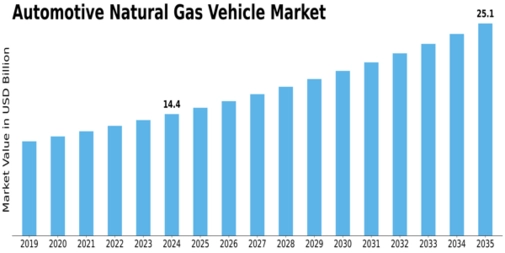Automotive Natural Gas Vehicle Market: Driving Toward a Cleaner and Cost-Efficient Future

The global Automotive Natural Gas Vehicle (NGV) Market is gaining momentum as consumers, businesses, and governments increasingly shift toward sustainable mobility solutions. With rising fuel costs and stricter environmental regulations, natural gas vehicles are becoming a practical and eco-friendly alternative to conventional gasoline and diesel vehicles. The market is witnessing significant technological advancements, improved refueling infrastructure, and supportive policy frameworks that are fueling its growth worldwide.
Eco-Friendly Mobility at Its Core
Natural gas vehicles (NGVs) run primarily on compressed natural gas (CNG) or liquefied natural gas (LNG), both of which emit fewer pollutants compared to traditional fuels. These vehicles produce up to 25% less carbon dioxide and significantly lower levels of nitrogen oxide and particulate matter, making them a cleaner option for both urban and rural transportation. Governments across various countries are promoting NGVs by offering tax incentives, fuel subsidies, and grants to encourage adoption.
Beyond the environmental benefits, natural gas is abundantly available and often domestically sourced, reducing dependence on imported oil. This aspect strengthens energy security while supporting local economies through natural gas production and distribution networks.
Market Growth Drivers
The rapid growth of the automotive natural gas vehicle market can be attributed to several key factors:
-
Rising Fuel Prices: As petrol and diesel prices fluctuate, natural gas offers a stable and cost-effective alternative.
-
Stringent Emission Regulations: Global initiatives aimed at reducing carbon footprints have accelerated the adoption of cleaner fuels.
-
Technological Innovation: Advances in engine design, storage systems, and fuel injection technology are improving vehicle performance and driving efficiency.
-
Infrastructure Development: Expansion of CNG and LNG refueling stations worldwide is making NGVs more accessible for both private and commercial users.
Major automotive manufacturers are increasingly offering CNG or LNG variants in passenger cars, light commercial vehicles, and heavy-duty trucks. Countries like India, China, Iran, and Brazil are leading the market, while North America and Europe are catching up due to environmental commitments and the growing availability of natural gas infrastructure.
Challenges and Future Outlook
Despite the positive outlook, the market faces challenges such as limited refueling stations in certain regions and the higher upfront cost of NGVs compared to conventional vehicles. However, as infrastructure expands and economies of scale reduce manufacturing costs, the market is expected to witness accelerated growth in the coming years.
The future of the automotive natural gas vehicle market looks promising, with hybrid and dual-fuel technologies set to further enhance efficiency and flexibility. As sustainability becomes central to automotive strategies, NGVs are likely to play a pivotal role in bridging the transition between fossil fuels and fully electric mobility solutions.
FAQs
1. What is an automotive natural gas vehicle (NGV)?
An NGV is a vehicle powered by compressed natural gas (CNG) or liquefied natural gas (LNG) instead of conventional petrol or diesel, offering lower emissions and reduced fuel costs.
2. Are natural gas vehicles environmentally friendly?
Yes. NGVs emit fewer greenhouse gases and air pollutants, contributing to cleaner air and a smaller carbon footprint compared to traditional internal combustion vehicles.
3. What are the main advantages of NGVs?
They offer lower running costs, reduced emissions, and quieter operation. Additionally, natural gas prices are more stable and less affected by global oil market fluctuations.
4. What is the future of the automotive natural gas vehicle market?
The market is expected to grow rapidly as more governments promote cleaner fuels, infrastructure expands, and automakers invest in hybrid and dual-fuel technologies.
- Art
- Education et Formation
- Crafts
- Sciences et Technologies
- Economie
- Politique
- Actualité
- Littérature
- Divertissement
- Histoire
- Health
- Actualité
- Shopping & Commerce
- Music
- Agriculture & élevage
- Voyage et Evènementiel
- Beauté & esthétique
- Religion
- Festival
- Sports
- Fête
- Autres



